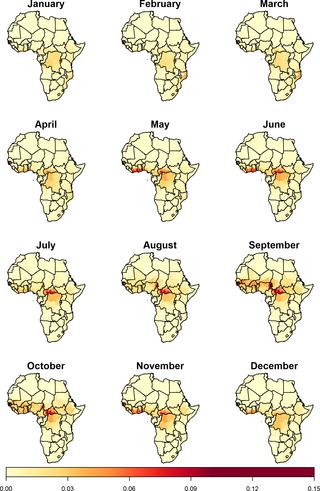PLOS Neglected Tropical Diseases ( IF 3.4 ) Pub Date : 2018-03-15 , DOI: 10.1371/journal.pntd.0006284 Arran Hamlet 1 , Kévin Jean 1, 2 , William Perea 3 , Sergio Yactayo 3 , Joseph Biey 4 , Maria Van Kerkhove 3, 5 , Neil Ferguson 1 , Tini Garske 1

|
Background
Yellow fever virus (YFV) is a vector-borne flavivirus endemic to Africa and Latin America. Ninety per cent of the global burden occurs in Africa where it is primarily transmitted by Aedes spp, with Aedes aegypti the main vector for urban yellow fever (YF). Mosquito life cycle and viral replication in the mosquito are heavily dependent on climate, particularly temperature and rainfall. We aimed to assess whether seasonal variations in climatic factors are associated with the seasonality of YF reports.
Methodology/Principal findings
We constructed a temperature suitability index for YFV transmission, capturing the temperature dependence of mosquito behaviour and viral replication within the mosquito. We then fitted a series of multilevel logistic regression models to a dataset of YF reports across Africa, considering location and seasonality of occurrence for seasonal models, against the temperature suitability index, rainfall and the Enhanced Vegetation Index (EVI) as covariates alongside further demographic indicators. Model fit was assessed by the Area Under the Curve (AUC), and models were ranked by Akaike’s Information Criterion which was used to weight model outputs to create combined model predictions. The seasonal model accurately captured both the geographic and temporal heterogeneities in YF transmission (AUC = 0.81), and did not perform significantly worse than the annual model which only captured the geographic distribution. The interaction between temperature suitability and rainfall accounted for much of the occurrence of YF, which offers a statistical explanation for the spatio-temporal variability in transmission.
Conclusions/Significance
The description of seasonality offers an explanation for heterogeneities in the West-East YF burden across Africa. Annual climatic variables may indicate a transmission suitability not always reflected in seasonal interactions. This finding, in conjunction with forecasted data, could highlight areas of increased transmission and provide insights into the occurrence of large outbreaks, such as those seen in Angola, the Democratic Republic of the Congo and Brazil.
中文翻译:

气候和环境对非洲黄热病传播的季节性影响
背景
黄热病病毒 (YFV) 是一种媒介传播的黄病毒,流行于非洲和拉丁美洲。90% 的全球负担发生在非洲,主要由伊蚊传播,埃及伊蚊是城市黄热病 (YF) 的主要媒介。蚊子的生命周期和蚊子中的病毒复制在很大程度上取决于气候,特别是温度和降雨量。我们旨在评估气候因素的季节性变化是否与 YF 报告的季节性有关。
方法论/主要发现
我们构建了 YFV 传播的温度适宜性指数,捕捉蚊子行为和蚊子内病毒复制的温度依赖性。然后,我们将一系列多级逻辑回归模型拟合到整个非洲的 YF 报告数据集,考虑季节性模型的位置和发生的季节性,对照温度适宜性指数、降雨量和增强植被指数 (EVI) 作为协变量以及进一步的人口统计指标. 模型拟合由曲线下面积 (AUC) 评估,模型由 Akaike 的信息标准排名,该标准用于加权模型输出以创建组合模型预测。季节性模型准确地捕捉了 YF 传播的地理和时间异质性(AUC = 0.81),并且没有明显比仅捕获地理分布的年度模型差。温度适宜性和降雨之间的相互作用是 YF 发生的主要原因,这为传输的时空变化提供了统计解释。
结论/意义
对季节性的描述为整个非洲西-东 YF 负担的异质性提供了解释。年度气候变量可能表明传播适宜性并不总是反映在季节性相互作用中。这一发现与预测数据相结合,可以突出传播增加的地区,并提供对大规模疫情发生的见解,例如在安哥拉、刚果民主共和国和巴西看到的那些。









































 京公网安备 11010802027423号
京公网安备 11010802027423号